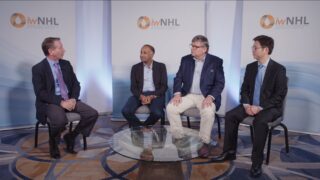Orelabrutinib is a newer covalent BTK inhibitor. It has been tested in multiple B-cell malignancies, mainly in the Asian population. Actually, in China, this drug was approved for mantle cell, marginal zone, and CLL in the relapsed setting. For example, in the mantle cell pivotal trial there, they included over 100 patients. The response rate was over 80%. The median duration of response was approaching two years in that pivotal study...
Orelabrutinib is a newer covalent BTK inhibitor. It has been tested in multiple B-cell malignancies, mainly in the Asian population. Actually, in China, this drug was approved for mantle cell, marginal zone, and CLL in the relapsed setting. For example, in the mantle cell pivotal trial there, they included over 100 patients. The response rate was over 80%. The median duration of response was approaching two years in that pivotal study. The purpose of this current phase 1-2 study is really to study this drug in the non-Asian population. This is a multi-center trial done in the United States and in Ukraine mainly. We had two parts of this phase 1-2 study. One is dose escalation to test the two dose levels. And then there’s a dose expansion part of testing different disease pathology. So this abstract we’re presenting at this meeting is to look at the data in mantle cell lymphoma, specifically combining patients from part one and part two who received the recommended phase two dose. So we had a total of 43 patients with relapsed mantle cell lymphoma. And the dosing in this study was 150 milligram daily. And with this current follow-up, the response rate is again over 80%, matching that seen in the Asian population. The CR rate is also very high, also matching that in the Asian population. In terms of duration of response, it has not been reached at this time. The continued response at two years is well over 60 to 70%. The overall progression-free survival, the median is not reached either. At two years the rate is again in the 60 to 70 range, close to 70, and then in terms of median overall survival at three years it’s above 70 percent, so these effects really mirror what we saw in the Asian population and maybe numerically slightly better than prior BTK inhibitors, although this is a cross-trial comparison. In terms of safety, it’s really very favorable in our experience having used all these covalent BTK inhibitors, including this one, in the trial setting. The most common treatment-emergent hematological toxicity includes anemia and thrombocytopenia, each at the 10% range, and neutropenia 7%, and lymphopenia 5%. In terms of grade 3 or above, the only notable hematological toxicity is really neutropenia 7%. Again, those are treatment-emergent, not necessarily treatment-related. In terms of non-hematological toxicity that is grade 3 above, we didn’t observe any in this trial. For adverse events of interest, we did not observe any atrial fibrillation in this trial with this current follow-up, and it was only one high-grade bleeding, which is a grade 3 hematuria, which was manageable. So overall, in summary, the safety profile was manageable. The efficacy results were very similar to what we saw in the Asian population. So, in my opinion, these data really support the development of this covalent BTK inhibitor in mantle cell lymphoma.
This transcript is AI-generated. While we strive for accuracy, please verify this copy with the video.














